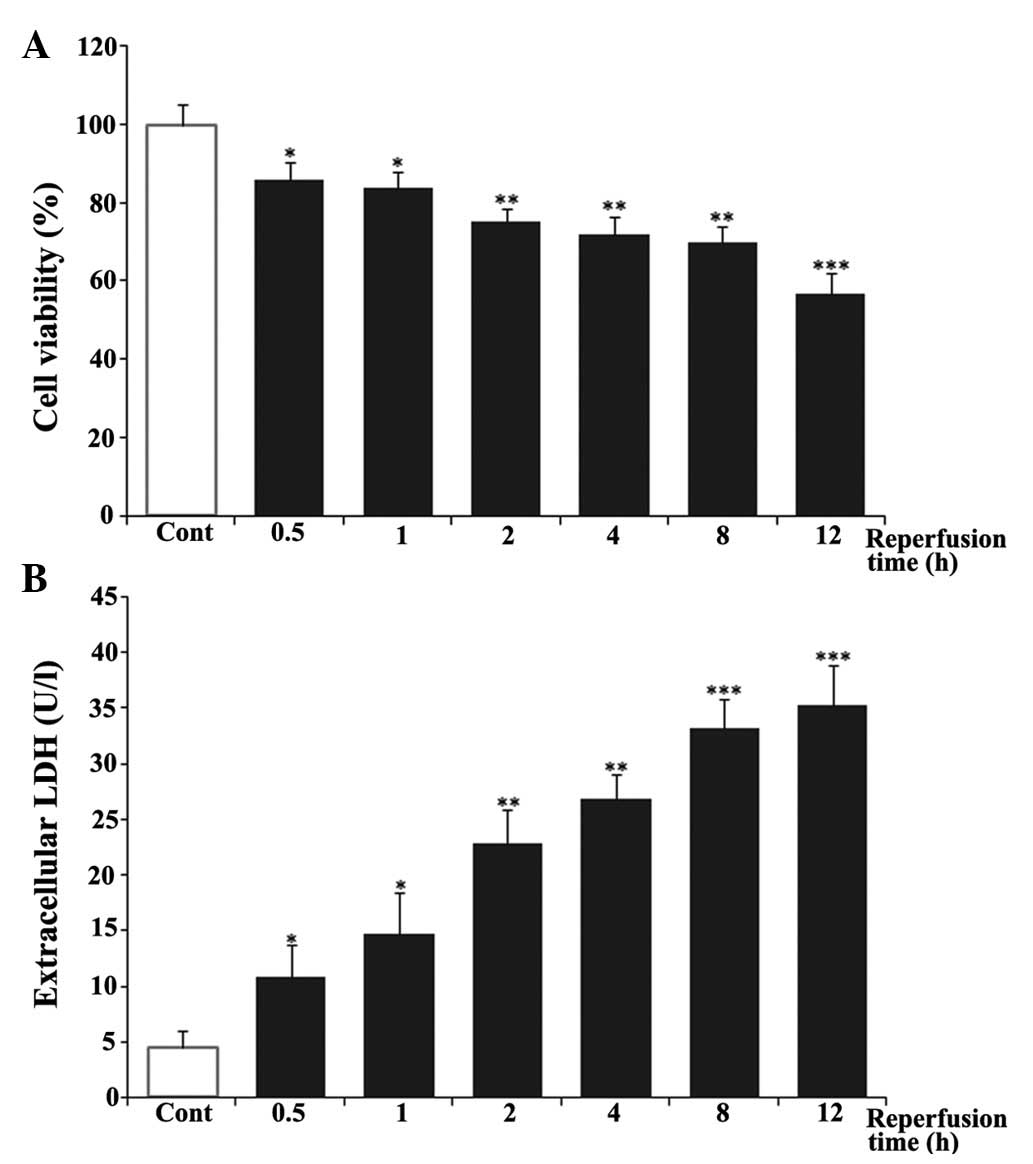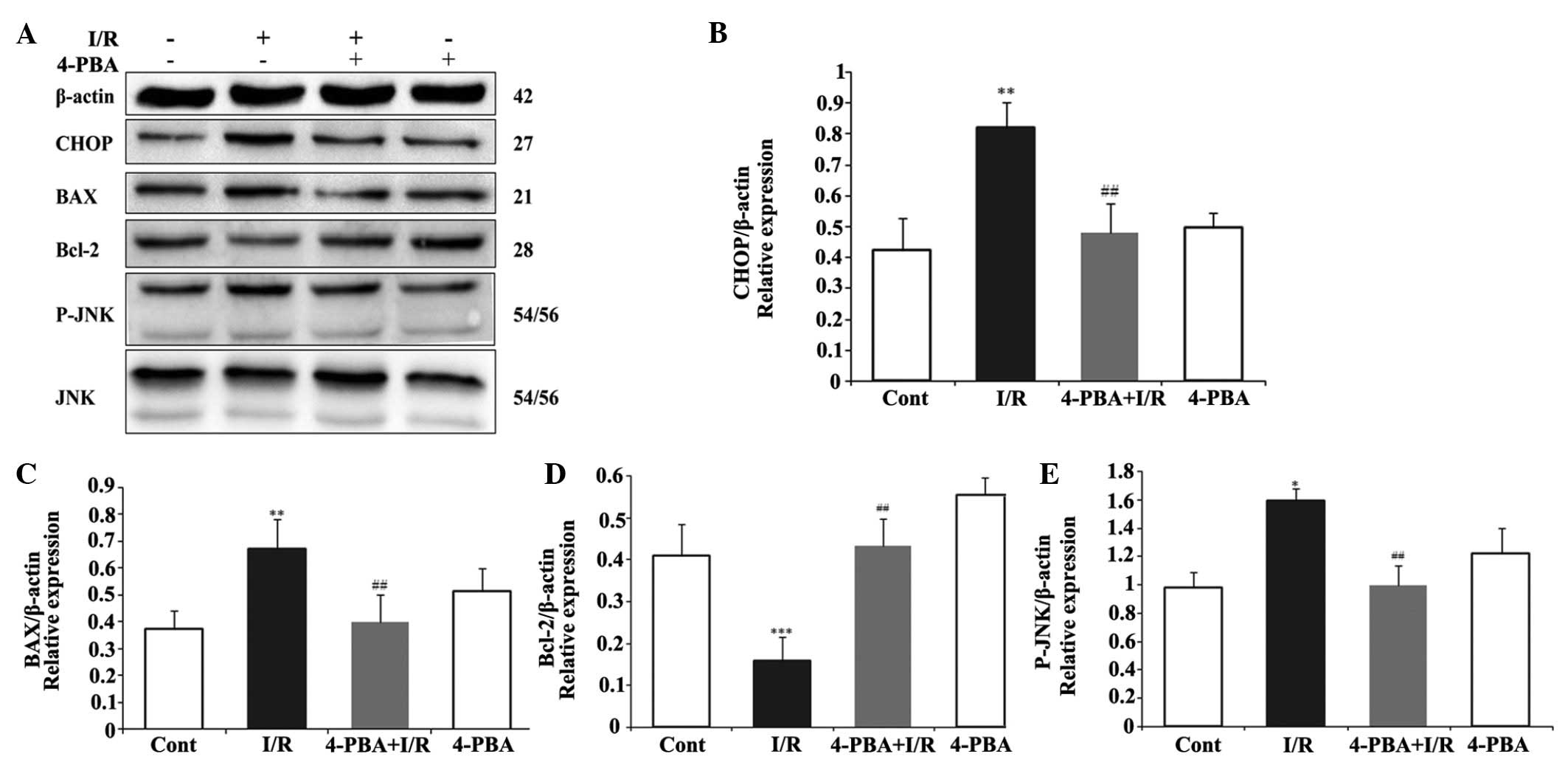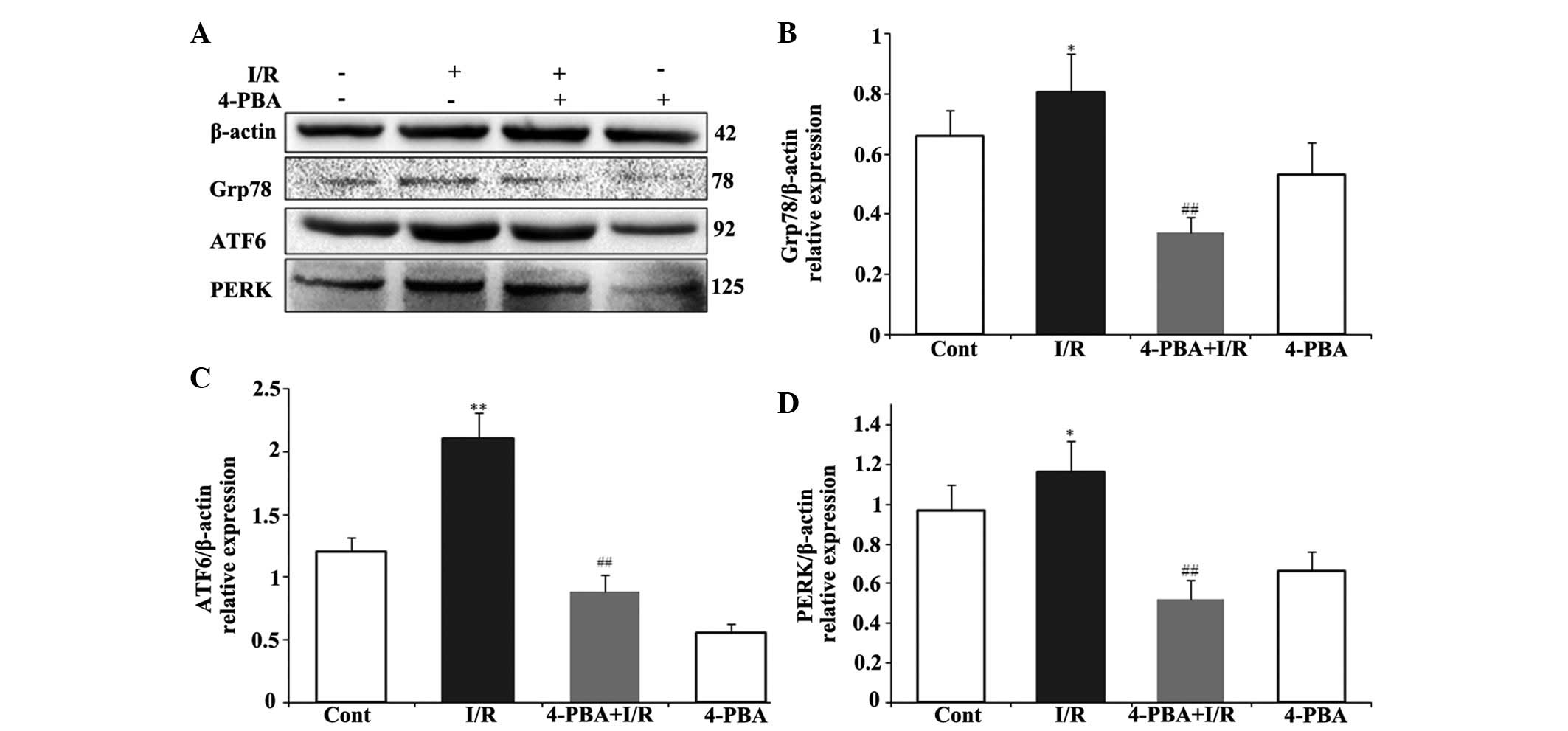|
1
|
Di Diego JM and Antzelevitch C: Acute
myocardial ischemia: Cellular mechanisms underlying ST segment
elevation. J Electrocardiol. 47:486–490. 2014. View Article : Google Scholar : PubMed/NCBI
|
|
2
|
Logue SE, Gustafsson AB, Samali A and
Gottlieb RA: Ischemia/reperfusion injury at the intersection with
cell death. J Mol Cell Cardiol. 38:21–33. 2005. View Article : Google Scholar
|
|
3
|
Minamino T and Kitakaze M: ER stress in
cardiovascular disease. J Mol Cell Cardiol. 48:1105–1110. 2010.
View Article : Google Scholar
|
|
4
|
Scarabelli TM and Gottlieb RA: Functional
and clinical repercussions of myocyte apoptosis in the multifaceted
damage by ischemia/reperfusion injury: Old and new concepts after
10 years of contributions. Cell Death Differ. 11(Suppl 2):
S144–S152. 2004. View Article : Google Scholar : PubMed/NCBI
|
|
5
|
Jennings RB, Sommers HM, Smyth GA, Flack
HA and Linn H: Myocardial necrosis induced by temporary occlusion
of a coronary artery in the dog. Arch Pathol. 70:68–78.
1960.PubMed/NCBI
|
|
6
|
Duan SR, Wang JX, Wang J, Xu R, Zhao JK
and Wang DS: Ischemia induces endoplasmic reticulum stress and cell
apoptosis in human brain. Neurosci Lett. 475:132–135. 2010.
View Article : Google Scholar : PubMed/NCBI
|
|
7
|
Kim I, Xu W and Reed JC: Cell death and
endoplasmic reticulum stress: Disease relevance and therapeutic
opportunities. Nat Rev Drug Discov. 7:101–1030. 2008. View Article : Google Scholar
|
|
8
|
Shen X, Zhang K and Kaufman RJ: The
unfolded protein response-a stress signaling pathway of the
endoplasmic reticulum. J Chem Neuroanat. 28:79–92. 2004. View Article : Google Scholar : PubMed/NCBI
|
|
9
|
Ron D and Walter P: Signal integration in
the endoplasmic reticulum unfolded protein response. Nat Rev Mol
Cell Biol. 8:519–529. 2007. View
Article : Google Scholar : PubMed/NCBI
|
|
10
|
Nishitoh H: Life and death under the ER
stress condition. Journal of Oral Biosciences. 46:259–269. 2004.
View Article : Google Scholar
|
|
11
|
Sozen E, Karademir B and Ozer NK: Basic
mechanisms in endoplasmic reticulum stress and relation to
cardiovascular diseases. Free Radic Biol Med. 78:30–41. 2015.
View Article : Google Scholar
|
|
12
|
Verfaillie T, Garg AD and Agostinis P:
Targeting ER stress induced apoptosis and inflammation in cancer.
Cancer Lett. 332:249–264. 2013. View Article : Google Scholar
|
|
13
|
Brusilow SW and Maestri NE: Urea cycle
disorders: Diagnosis, pathophysiology and therapy. Adv Pediatr.
43:127–170. 1996.
|
|
14
|
Qi X, Hosoi T, Okuma Y, Kaneko M and
Nomura Y: Sodium 4-phenylbutyrate protects against cerebral
ischemic injury. Mol Pharmacol. 66:899–908. 2004. View Article : Google Scholar : PubMed/NCBI
|
|
15
|
Vilatoba M, Eckstein C, Bilbao G, Smyth
CA, Jenkins S, Thompson JA, Eckhoff DE and Contreras JL: Sodium
4-phenylbutyrate protects against liver ischemia reperfusion injury
by inhibition of endoplasmic reticulum-stress mediated apoptosis.
Surgery. 138:342–351. 2005. View Article : Google Scholar : PubMed/NCBI
|
|
16
|
Wu CX, Liu R, Gao M, Zhao G, Wu S, Wu CF
and Du GH: Pinocembrin protects brain against ischemia/reperfusion
injury by attenuating endoplasmic reticulum stress induced
apoptosis. Neurosci Lett. 546:57–62. 2013. View Article : Google Scholar : PubMed/NCBI
|
|
17
|
Mimori S, Ohtaka H, Koshikawa Y, Kawada K,
Kaneko M, Okuma Y, Nomura Y, Murakami Y and Hamana H:
4-Phenylbutyric acid protects against neuronal cell death by
primarily acting as a chemical chaperone rather than histone
deacetylase inhibitor. Bioorg Med Chem Lett. 23:6015–6018. 2013.
View Article : Google Scholar : PubMed/NCBI
|
|
18
|
Kuang X, Hu W, Yan M and Wong PK:
Phenylbutyric acid suppresses protein accumulation-mediated ER
stress in retrovirus-infected astrocytes and delays onset of
paralysis in infected mice. Neurochem Int. 57:738–748. 2010.
View Article : Google Scholar : PubMed/NCBI
|
|
19
|
Sun J, Sun G, Meng X, Wang H, Wang M, Qin
M, Ma B, Luo Y, Yu Y, Chen R, et al: Ginsenoside RK3 prevents
hypoxia-reoxygenation induced apoptosis in H9c2 cardiomyocytes via
AKT and MAPK pathway. Evid Based Complement Alternat Med.
2013:6901902013. View Article : Google Scholar : PubMed/NCBI
|
|
20
|
Sun L, Isaak CK, Zhou Y, Petkau JC, O K,
Liu Y and Siow YL: Salidroside and tyrosol from Rhodiola protect
H9c2 cells from ischemia/reperfusion-induced apoptosis. Life Sci.
91:151–158. 2012. View Article : Google Scholar : PubMed/NCBI
|
|
21
|
Yuan Y, Guo Q, Ye Z, Pingping X, Wang N
and Song Z: Ischemic postconditioning protects brain from
ischemia/reperfusion injury by attenuating endoplasmic reticulum
stress-induced apoptosis through PI3K-Akt pathway. Brain Res.
1367:85–93. 2011. View Article : Google Scholar
|
|
22
|
Kim HD, Jang CY, Choe JM, Sohn J and Kim
J: Phenylbutyric acid induces the cellular senescence through an
Akt/p21(WAF1) signaling pathway. Biochem Biophys Res Commun.
422:213–218. 2012. View Article : Google Scholar : PubMed/NCBI
|
|
23
|
Park CS, Cha H, Kwon EJ, Sreenivasaiah PK
and Kim do H: The chemical chaperone 4-phenylbutyric acid
attenuates pressure-overload cardiac hypertrophy by alleviating
endoplasmic reticulum stress. Biochem Biophys Res Commun.
421:578–584. 2012. View Article : Google Scholar : PubMed/NCBI
|
|
24
|
Ayala P, Montenegro J, Vivar R, Letelier
A, Urroz PA, Copaja M, Pivet D, Humeres C, Troncoso R, Vicencio JM,
et al: Attenuation of endoplasmic reticulum stress using the
chemical chaperone 4-phenylbutyric acid prevents cardiac fibrosis
induced by isoproterenol. Exp Mol Pathol. 92:97–104. 2012.
View Article : Google Scholar
|
|
25
|
Yamamoto K, Yoshida H, Kokame K, Kaufman
RJ and Mori K: Differential contributions of ATF6 and XBP1 to the
activation of endoplasmic reticulum stress-responsive cis-acting
elements ERSE, UPRE and ERSE-II. J Biochem. 136:343–350. 2004.
View Article : Google Scholar : PubMed/NCBI
|
|
26
|
Wang WA, Groenendyk J and Michalak M:
Endoplasmic reticulum stress associated responses in cancer.
Biochim Biophys Acta. 1843:2143–2149. 2014. View Article : Google Scholar : PubMed/NCBI
|
|
27
|
Powell KS and Latterich M: The making and
breaking of the endoplasmic reticulum. Traffic. 1:689–694. 2000.
View Article : Google Scholar
|
|
28
|
Cullinan SB and Diehl JA: Coordination of
ER and oxidative stress signaling: The PERK/Nrf2 signaling pathway.
Int J Biochem Cell Biol. 38:317–332. 2006. View Article : Google Scholar
|
|
29
|
Ye J, Rawson RB, Komuro R, Chen X, Davé
UP, Prywes R, Brown MS and Goldstein JL: ER stress induces cleavage
of membrane-bound ATF6 by the same proteases that process SREBPs.
Mol Cell. 6:1355–1364. 2000. View Article : Google Scholar
|
|
30
|
Owen CR, Kumar R, Zhang P, McGrath BC,
Cavener DR and Krause GS: PERK is responsible for the increased
phosphorylation of eIF2alpha and the severe inhibition of protein
synthesis after transient global brain ischemia. J Neurochem.
94:1235–1242. 2005. View Article : Google Scholar : PubMed/NCBI
|
|
31
|
Zhu S, Jin J, Wang Y, Ouyang Z, Xi C, Li
J, Qiu Y, Wan J, Huang M and Huang Z: The endoplasmic reticulum
stress response is involved in apoptosis induced by aloe-emodin in
HK-2 cells. Food Chem Toxicol. 50:1149–1158. 2012. View Article : Google Scholar : PubMed/NCBI
|
|
32
|
Li H, Zhu X, Fang F, Jiang D and Tang L:
Down-regulation of GRP78 enhances apoptosis via CHOP pathway in
retinal ischemia-reperfusion injury. Neurosci Lett. 575:68–73.
2014. View Article : Google Scholar : PubMed/NCBI
|
|
33
|
Vaughn LS, Snee B and Patel RC: Inhibition
of PKR protects against tunicamycin-induced apoptosis in
neuroblastoma cells. Gene. 536:90–96. 2014. View Article : Google Scholar
|














